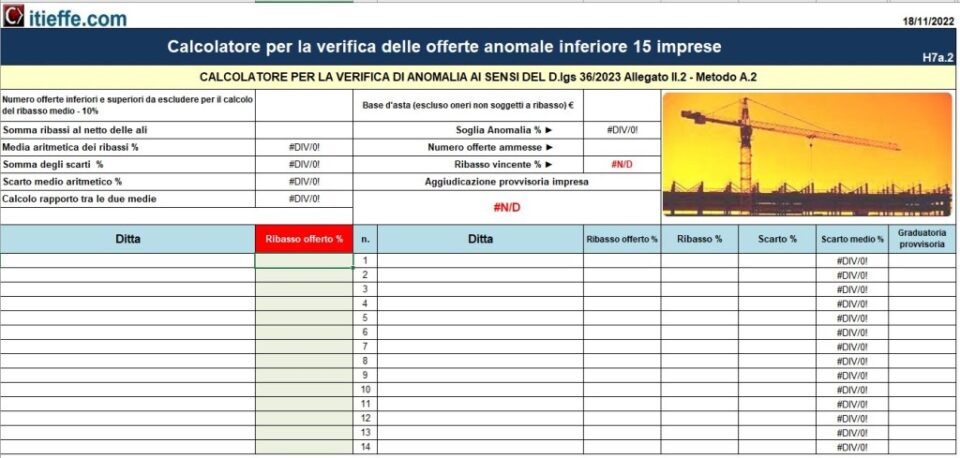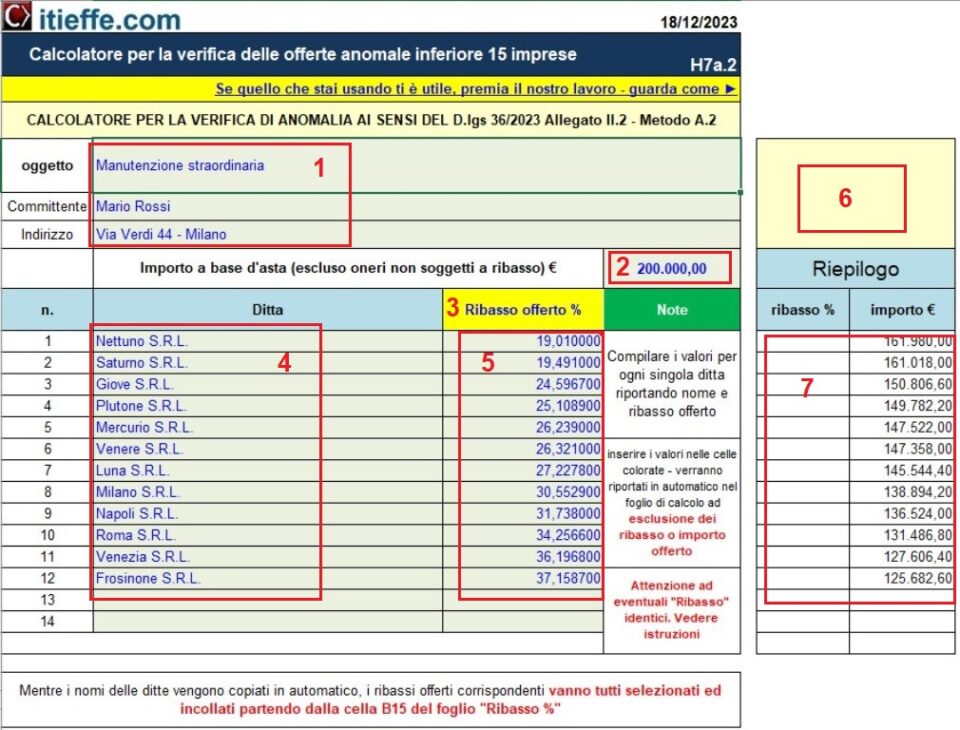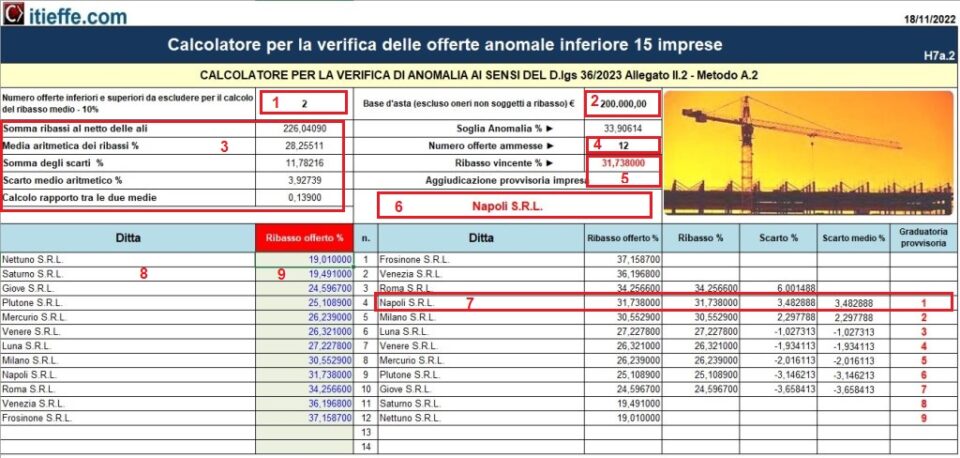Calculator checks anomalous offers

Free program that automatically checks anomalous offers (up to 14) As dictated by Legislative Decree 36/2023 Annex II.2 Method A point 2
We are pleased to present this program designed and created by Itieffe dedicated to public works. In a context in which transparency, efficiency and correctness are essential for the successful outcome of infrastructure projects, this tool aims to be your ally in the accurate and timely verification of offers submitted by companies, according to legal directives.
The world of public works
requires a meticulous approach to ensure correct allocation of resources, quality of performance and adherence to strict regulations. This “Verification Calculator” was developed to facilitate the proposal analysis process, quickly and precisely identifying any anomalies and discrepancies that could raise doubts about the validity of the offers themselves.
Who is this program aimed at?
This tool is aimed at sector professionals, public bodies and all figures involved in the management of public works. Its intuitive interface, together with advanced analytical features, aims to simplify the complex verification process, while promoting transparency and legality in procurement procedures.
Reliable and based on sophisticated algorithms, this Calculator represents a bulwark against any unfair practices, helping to preserve the integrity of the procurement process and ensuring that public resources are used in the best possible way.
We invite you to explore the potential of this tool with confidence, aware that its targeted use will result in more efficient and transparent management of public works.
Calculator checks for anomalous offers less than 15
There is a lot of material online that offers indications on how to verify anomalous offers. Some offer free calculation programs but which are difficult to understand and use, others offer them for a fee but with considerable costs.
We provide a completely free and above all easy-to-use program complete with detailed instructions. Anyone, if a registered user, can download and use it as they wish (the version is in Microsoft Excel).
By entering only the tender amount and the names of the companies with the related discounts offered, the program immediately calculates the winning discount and indicates the name of the company that has the provisional award.
Performs these operations pursuant to Legislative Decree 36/2023 Annex II.2 – Method A point 1 – Method A point 2 and Method B.
In this case, the free program automatically carries out the calculation for the verification of anomalous offers as dictated by Legislative Decree 36/2023 Annex II.2 – Method A point 2 (up to 14 offers).
In the case of offers exceeding 15, Method A point 1 of the same Legislative Decree is used and the program is used: "Calculator for checking anomalous offers >15 companies".
Legislative Decree 36/2023 Annex II.2 Method A point 2
2) When the number of offers admitted is less than fifteen, the adequacy of the offers is assessed on the offers that present a reduction equal to or greater than a specific anomaly threshold; for the purposes of determining the adequacy of the offers, in order not to make the reference parameters for the calculation of the anomaly threshold pre-determinable by the bidders, the RUP or the judging commission proceeds as follows:
a) calculation of the arithmetic mean of the percentage reductions of all the admitted offers, with the exclusion of 10 percent, rounded to the nearest whole number, respectively of the offers with the greatest reduction and those with the lowest reduction; offers having an equal discount value are taken into consideration separately in their individual values; if, when calculating the 10 percent, there are one or more offers of equal value to the offers to be set aside, said offers must also be set aside;
b) calculation of the arithmetic mean deviation of the percentage reductions that exceed the average calculated pursuant to letter a), excluding those set aside pursuant to letter a);
c) calculation of the ratio between the arithmetic mean deviation referred to in letter b) and the arithmetic mean referred to in letter a);
d) if the ratio referred to in letter c) is equal to or less than zero point fifteen, the anomaly threshold is equal to the value of the arithmetic mean referred to in letter a) increased by 20 percent of the same arithmetic mean);
e) if the ratio referred to in letter c) is greater than zero point fifteen, the anomaly threshold is calculated as the sum of the arithmetic mean referred to in letter a) and the arithmetic mean deviation referred to in letter b).
Regardless of the mechanisms adopted for identifying anomalous offers and the number of offers, the contracting authority can still evaluate the adequacy of each offer which, based on specific elements, appears abnormally low (art. 54 paragraph 1 of the Code).
If from the technical judgment of the contracting authority the adequacy, seriousness, sustainability and feasibility of the offer is doubtful, even in this case the economic operator is obliged to provide all the explanations requested on the proposed price or costs (art. 110, paragraph 2 of the Code).
Calculator checks anomalous offers below 15
By entering only the amount based on the tender and the names of the companies with the relative discounts (or amounts) offered, the program immediately calculates the winning discount and indicates the name of the company that has the provisional award.
Free software
which automatically carries out the calculation for the verification of anomalous offers as dictated by Legislative Decree 36/2023 Annex II.2 Method A point 2 (up to 14 offers).
Instructions for the program for calculating the anomaly threshold (up to 15 companies).
Calculator checks anomalous offers

Let's start by entering the tender data including the names of the companies and the discounts offered (or amounts offered) even in no particular order:
- enter the tender information;
- enter the amount based on the tender with the exclusion of charges not subject to reduction;
- entry deleted;
- enter the names of the companies participating in the tender, these names will be automatically reported in the corresponding sections of the sheets: Calcolo% and Calcolo €;
- enter the discount or the amount offered. These values must all be selected and pasted in the sheets: Calculation% or Calculation € (the only thing that is done manually) starting from cell B15;
- if the message appears: "ATTENTION IDENTICAL VALUES PRESENT"The data is not valid (non-binding advice: for identical discounts or offered amounts (they turn red), try to change the first discount / amount by adding 0,01 value and see the award results, then do the same with the second is to double check the results.There must be no variations.This task (which is quite rare among other things) is referred to the personal choice of the compiler (Note 1);
- simple converter that indicates the amounts according to the discount and vice versa (discounts according to the amounts).
Note 1: offers with an equal discount value are taken into consideration separately in their individual values; if, when calculating the 10 per cent, there are one or more offers of equal value with respect to the offers to be set aside, said offers must also be set aside (the program does not provide for this);
Now let's proceed with analyzing the second part.

- here is the number of offers that will be excluded to make the average discount equal to 10% of the same (calculation of the sum and the arithmetic average of the percentage discounts of all admitted offers, with the exception of 10 per cent, rounded up to the higher unit, respectively of the offers with the highest discount and those with the lowest discount);
- shows the auction base amount with the exclusion of charges not subject to reduction, coming from the "Data" section;
- Automatic calculations of the items indicated;
- the number of offers accepted is indicated;
- the winning discount is shown;
- the name of the company awarded provisionally is shown;
- all the data of the provisional award are indicated;
- automatic reporting of companies from "Data";
- cell B15 where to start pasting values.
This program is given free of charge. Any use is under the direct responsibility of the compiler. Carry out appropriate checks before judging it reliable and usable.
Reporting any inconveniences via email to: info@itieffe.com
Warning: program designed for desktop, although usable, not suitable for smartphones.
Other free programs of the same kind offered by itieffe ▼
To access the full program, you must be registered
You can register now by clicking HERE
